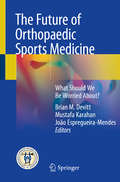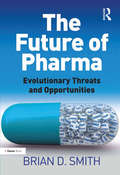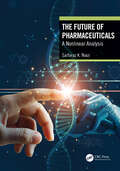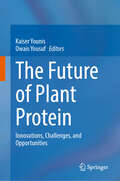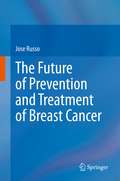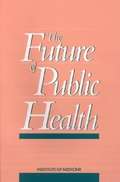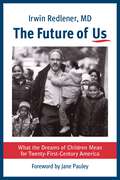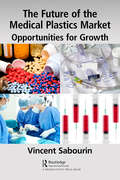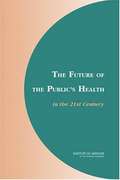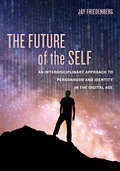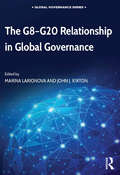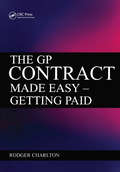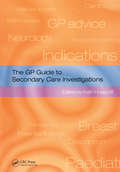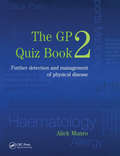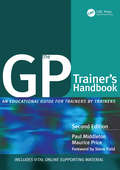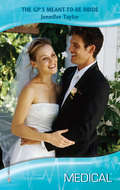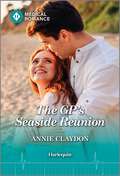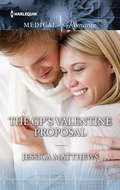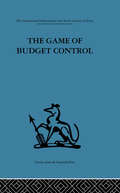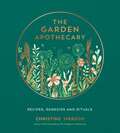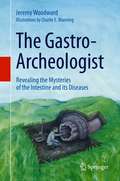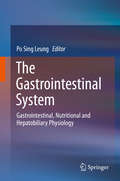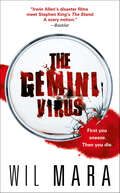- Table View
- List View
The Future of Orthopaedic Sports Medicine: What Should We Be Worried About?
by Mustafa Karahan João Espregueira-Mendes Brian M. DevittIn this book, leading international thinkers in the still nascent field of orthopaedic sports medicine consider what the future holds and give their views on what we should be most worried about. The range of issues addressed is wide, encompassing technological threats, environmental concerns, big data and its ramifications, the influence of industry, academic ethics, and much more. Many of the identified dangers are not yet on the popular radar, and these are the principal focus of the book. On the other hand, attention is also paid to misplaced fears, with explanation as to why these anxieties can be laid to rest. The contributors are leading thinkers in the field and include original pioneers of sports medicine, senior and newly appointed orthopaedic surgeons, orthopaedic trainees, and sports medicine physicians. In addition, leaders of industry in sports medicine and allied health professionals from around the world share their fears. This compelling and thought-provoking book, published in collaboration with ISAKOS, will appeal to all stakeholders in orthopaedic sports medicine.
The Future of Pharma: Evolutionary Threats and Opportunities
by Brian D. SmithBy any standard, the pharmaceutical industry's history has been a successful one. In addition to its profits and shareholder dividends, it has been seen by investors as relatively low risk and, largely, counter-cyclical to stock market trends. However, that important contribution appears to be petering out, with significant global implications for employees, shareholders, governments and patients. This is not just caused by the economic crisis. Long before this, several distinct but related streams of evidence emerged that now point to the stalling of the pharmaceutical industry. The Future of Pharma examines the causes of the industry's potential decline and offers a convincing and rigorous analysis of the options open to it. What emerges is a landscape defined, on the one hand, by the changing marketplace of mass-market consumers, institutional healthcare systems and wealthy individuals; and on the other by the alternate sources of commercial value - innovative therapies; super-efficient processes, supply chains and operations; and closer customer relations and increasingly tailored health services. The challenges to the pharmaceutical industry now and in the medium and long-term are very significant. Brian Smith's highly readable research findings are a wake-up call and a first step forward for anyone concerned with the future of the industry; whether executive, customer, policymaker or investor.
The Future of Pharmaceuticals: A Nonlinear Analysis
by Sarfaraz K. NiaziBefore now, biological systems could only be expressed in terms of linear relationships, however, as knowledge grows and new techniques of analysis on biological systems is made available, we are realizing the non-linearity of these systems. The concepts and techniques of nonlinear analysis allow for more realistic and accurate models in science. The Future of Pharmaceuticals: A Nonlinear Analysis provides an opportunity to understand the non-linearity of biological systems and its application in various areas of science, primarily pharmaceutical sciences. This book will benefit professionals in pharmaceutical industries, academia, and policy who are interested in an entirely new approach to how we will treat disease in the future. Key Features: Addresses a new approach of nonlinear analysis. Applies a theory of projection to chalk out the future, instead of basing on linear evolution. Provides an opportunity to better understand the non-linearity in biological systems and its applications in various areas of science, primarily pharmaceutical sciences. Helps change the thought process for those looking for answers to their questions which they do not find in the linear relationship approach. Encourages a broader perspective for the creative process of drug development.
The Future of Plant Protein: Innovations, Challenges, and Opportunities
by Kaiser Younis Owais YousufThis book presents plant proteins as sustainable and healthy substitutes for animal proteins, highlighting innovations, challenges, and opportunities. Chapters cover emerging sources like duckweed, microalgae, quinoa, and hemp, comparing their nutritional aspects with traditional sources such as soybeans, beans, and nuts. Further chapters not only discuss the environmental impact, production methods, and potential applications of plant protein but also address barriers like consumer perception, affordability, and distribution. The book provides solutions from plant-based food companies to these challenges, tackling the rising global demand driven by population growth, income increase, urbanization, environmental awareness, health consciousness, and animal welfare concerns. Overall, it provides a summary of plant proteins, exploring their nutritional, environmental, and consumer-related aspects in the context of a shifting protein landscape. The book is relevant forfood scientists and technologists, nutritionists, policymakers, and professionals alike providing insights into plant-based diets and the future of food.
The Future of Prevention and Treatment of Breast Cancer
by Jose RussoThe objective of this book is to provide a critical analysis of the present prevention strategies for breast cancer, emphasizing the cost benefits and quality of life of the patient. Rooted in the present knowledge of breast cancer biology and prevention and treatment options, the book will describe the future tools that could be available to oncologists and how these new approaches may change the landscape of recurrence and survival of the disease. Special emphasis will be given to the prevention strategies counterposing the present limitations and conflicting prevention guidelines for both hereditary and preventive non-hereditary breast cancer, and propose how the implementation of new strategies based on the present knowledge could save millions of lives and be more cost efficient. The book will present a critical status of the treatment and prevention of breast cancer and detail how a quantum leap could be achieved in the field by applying present basic research knowledge to clinical application.
The Future of Public Health
by Committee for the Study of the Future of Public HealthThe Nation has lost sight of its public health goals and has allowed the system of public health to fall into 'disarray', from The Future of Public Health. This startling book contains proposals for ensuring that public health service programs are efficient and effective enough to deal not only with the topics of today, but also with those of tomorrow. In addition, the authors make recommendations for core functions in public health assessment, policy development, and service assurances, and identify the level of government--federal, state, and local--at which these functions would best be handled.
The Future of Us: What the Dreams of Children Mean for Twenty-First-Century America
by Irwin RedlenerRaymond is a talented young artist who carries his work from homeless shelter to homeless shelter in a tattered bag but has never even been inside a museum. He is emblematic of the children that the renowned pediatrician and children’s advocate Irwin Redlener has met over the course of his long and colorful career. Inadequate education, barriers to health care, and crushing poverty make it overwhelmingly difficult for many children to realize their dreams. In this memoir, Redlener draws on poignant personal experiences to investigate the nation’s healthcare safety net and special programs that are designed to protect and nurture our most vulnerable kids, but that too often fail to do so. The book follows Redlener’s winding career, from his work as a pediatrician in the Arkansas delta, to treating child abuse in a Miami hospital, to helping children in the aftermath of 9/11 and Hurricane Katrina. The reader accompanies him to the board of USA for Africa, to cofounding the Children’s Health Fund with Paul Simon, as he persuades Joan Baez to play a benefit concert for his clinic in rural Arkansas, and to dinner with Fidel Castro. But what has motivated him most powerfully are the children who struggle with terrible adversities yet dream of becoming paleontologists, artists, and marine biologists. These stories are his springboard for discussing larger policy issues that hinder us from effectively eradicating childhood poverty and overcoming barriers to accessible health care. Persistent deprivation and the avoidable problems that accompany poverty ensnare millions of children, with rippling effects that harm the health, prosperity, and creativity of the adults they become. Redlener argues that we must drastically change our approach to meeting the needs of children—for their sake and to ensure America’s resiliency and influence in an increasingly complex and challenging world.
The Future of the Medical Plastics Market: Opportunities for Growth
by Vincent SabourinPlastics have occupied an important place in the modern medical industry. It has substituted traditional devices and products made of metal, other materials, and ceramics. Over recent years, increased reliance on transparent plastic pharmaceutical and medical products has produced remarkable breakthroughs that improve medical attention delivery and allow it to be more comfortable for the masses to live better and longer lives. The purpose of this handbook is to provide a strategic perspective on the market to identify opportunities for growth and promising niches in the medical plastics market. It also helps in analyzing emerging trends in medical plastics to facilitate new product development. The medical plastics market is a new field with a broad scope and unending opportunities for manufacturers and suppliers and medical practitioners from healthcare. With a combination of the right material and technology, it has a lot to offer to the patients with affordable pricing. By keeping the worth of the medical plastics market in mind, we have set some objectives. This book identifies growth factors in the medical plastics market and analyzes critical factors of success to compete. The author presents background on the medical plastics market by its usage, products, processes, and innovation. He also reviews existing studies on the medical plastics market for topics like market size, market growth, segment growth, and geographic markets.
The Future of the Public's Health in the 21st Century
by Institute of Medicine U. S., Committee on Assuring the Health of the Public in the 21st CenturyThe anthrax incidents following the 9/11 terrorist attacks put the spotlight on the nation's public health agencies, placing it under an unprecedented scrutiny that added new dimensions to the complex issues considered in this report. The Future of the Public's Health in the 21st Century reaffirms the vision of Healthy People 2010, and outlines a systems approach to assuring the nation's health in practice, research, and policy. This approach focuses on joining the unique resources and perspectives of diverse sectors and entities and challenges these groups to work in a concerted, strategic way to promote and protect the public's health. Focusing on diverse partnerships as the framework for public health, the book discusses: The need for a shift from an individual to a population-based approach in practice, research, policy, and community engagement. The status of the governmental public health infrastructure and what needs to be improved, including its interface with the health care delivery system. The roles nongovernment actors, such as academia, business, local communities and the media can play in creating a healthy nation. Providing an accessible analysis, this book will be important to public health policy-makers and practitioners, business and community leaders, health advocates, educators and journalists.
The Future of the Self: An Interdisciplinary Approach to Personhood and Identity in the Digital Age
by Jay FriedenbergWe live in the digital age where our sense of self and identity has moved beyond the body to encompass hardware and software. Cyborgs, online representations in social media, avatars, and virtual reality extend our notion of what it means to be human. This book looks at the progression of self from the biological to the technological using a multidisciplinary approach. It examines the notion of personhood from philosophical, psychological, neuroscience, robotics, and artificial intelligence perspectives, showing how the interface between bodies, brains, and technology can give rise to new forms of human identity. Jay Friedenberg presents the content in an organized and easy-to-understand fashion to facilitate learning. A gifted researcher, author, and classroom teacher, he is one of the most influential voices in the field of artificial psychology.
The G8-G20 Relationship in Global Governance (Global Governance)
by Marina Larionova John J. KirtonIf the growing demand for global governance breathed new life into the established G7/8 and the more recent G20, it raised questions about the evolving and optimal relationship between them. One answer arose from the G20’s third summit, when it proclaimed the G20 would govern global finance and economics, while the old G8 would focus on development and security. Yet this rough division of labour did not address which issues lay within each category and how interconnections would be addressed to create comprehensive, coherent global governance for a complex world. This volume considers these questions. It explores the summits’ performance, the division of labour during their coexistence, their comparative strengths and limitations, and how the future partnership could be improved to benefit the global community. The authors explain the recent evolution and performance of the G8 and G20 summits and their evolving empirical relationship. They consider the G8/G20 relationship with other actors engaged in global governance, notably the major multilateral organizations and civil society. They assess G7/8 and G20 effectiveness and accountability. And they identify, based on this empirical and analytical foundation, how the relationship can be improved for today’s tightly wired world.
The GP Contract Made Easy: Getting Paid
by Rodger CharltonThe concepts and terminology of the new General Medical Services Contract can be confusing and daunting. The GP Contract Made Easy – Getting Paid summarises and simplifies a complex contract with many practical points to maximise a practice’s income and make the lives of doctors and managers easier. This book shows how the new Contract differs from the 1990 GP Contract, resulting in a change in the services that GPs provide and a change in their remuneration. This book provides advice on how GPs can maximise their income under the new regulations for the Global Sum, Enhanced Services and the quality indicators of the Quality and Outcomes Framework. General practitioners, primary care managers, and their professional advisers will find this book essential and invaluable reading.
The GP Guide to Secondary Care Investigations
by Keith HopcroftThis book provides practical guidelines for all those who in the course of their work are involved in the terminal care of children or supporting those affected by the death of a child. It sets out to provide the knowledge and reassurance to help them respond appropriately and aims to inspire the reader to deal confidently with bereavement and grief. It should therefore be of interest to health professionals and students as well as a wider audience including emergency services personnel, the police and teachers.
The GP Quiz: Bk.2
by Alick MunroThe handbook is a reference for any hospital pharmacy department which operates a cytotoxic reconstitution service or is considering starting this facility in the future. The book provides a step-by-step guide through the stages needed to start, maintain and develop a pharmacy-based cytotoxic service. The compendium presents drug monographs with general details of the drug, its chemistry, stability, profile, clinical use, preparation of the injection and final destruction/decontamination information.
The GP Trainer's Handbook: An Educational Guide for Trainers by Trainers
by Paul Middleton Maurice PriceThe ten years since the First Edition of this book have witnessed revolutionary changes in GP training: appraisal the new MRCGP exam and competence-based assessments to name but three. Greater availability of information has also transformed the social context of General Practice as a profession. Despite this the one-to-one relationship between trainer and trainee remains the lynchpin of GP education and this manual's key principle - that GP trainers are the key source of expertise in this field and that their experiences and ideas are a vital and still-underused resource - is as important as ever. This new edition fully revised and updated to reflect the latest changes in both GP training and the profession remains an essential comprehensive manual of useful advice for GP trainers written by their peers. Outlining educational methods training philosophies and reflections from practitioners experienced in the entire spectrum of GP education it provides a toolbox of resources to cover the practicalities of training including e-portfolios teaching consultation skills and numerous tips and tricks. It is now augmented with an array of supporting online material that includes checklists forms and evaluation tools. This book is vital reading for GP tutors and GP trainers as well as those considering such roles and for all those who manage and oversee the training of GP registrars.
The GP's Meant-To-Be Bride
by Jennifer TaylorFrom practice nurse to doctor's bride!Since GP Ross Mackenzie learned that his wedding had been cancelled the devastatingly handsome doctor's heart has been well and truly guarded. However, Ross cannot ignore the sparks that flicker between him and practice nurse Gemma Craven--sparks that refuse to diminish. . . Shy Gemma has learned to hide the scars on her body--especially from powerfully attractive men like Ross. But gradually Ross's compassion wins the vulnerable nurse's trust, and when his lips touch hers Gemma feels beautiful for the first time. Before long Ross realises that it is Gemma he wants as his bride. . . and it seems there just might be a wedding in Dalverston after all!
The GP's Seaside Reunion
by Annie ClaydonCan a seaside doc overcome her grief and embrace a fresh start with her med school crush? Find out in Annie Claydon&’s latest Harlequin Medical Romance! CAN THEY FULFILL THEIR DREAMS—TOGETHER? Dr. Hope wants to spread her wings beyond her seaside hometown and live life to the fullest now that her caring years are behind her. Only, she wasn&’t expecting the new locum at her practice to be Theo, her med school mentor and the man she once adored. Now their chemistry is both powerful and mutual, but unlike Hope, Theo&’s traveled the world and longs to put down roots. With their dreams diametrically opposed, is this just another way to say goodbye or the chance at forever they never had?From Harlequin Medical: Life and love in the world of modern medicine.
The GP's Secret Baby Wish: Risking Her Heart On The Trauma Doc / The Gp's Secret Baby Wish (Mills And Boon Medical Ser.)
by Sue MacKayIs the future she wants……just a dream?Four years ago, GP Lily Scott walked away from Dr. Max Bryant and their sizzling fling. Why? Well, if the past had taught Lily anything, it was to be cautious with her heart. But Lily’s rule book is about to go out the window, because Max is her new colleague! She can’t ignore their powerful connection—or the family she pictures—every time she’s with him. Can that family become a reality?From Harlequin Medical: Life and love in the world of modern medicine.
The GP's Valentine Proposal
by Jessica MatthewsShe only came to Hope City to solve a huge family mystery. An explosive encounter with a handsome doctor is the last thing Dr. Dixie Albright expects to add to her list of complications. But Dr. Mark Cameron is the key to discovering the truth at the heart of her family's problems. While he has no sympathy with Dixie's relative, he has won his way into Dixie's guarded heart. Now Dixie is at a crossroads: should she put her family's needs above her own, or should she allow Mark into her life? But, as Valentine's Day approaches, Mark shows her where her priorities and happiness really lie…. Hope City — A hospital, a clinic, a community — a place that lives up to its name
The Game of Budget Control
by G H HofstedeTavistock Press was established as a co-operative venture between the Tavistock Institute and Routledge & Kegan Paul (RKP) in the 1950s to produce a series of major contributions across the social sciences. This volume is part of a 2001 reissue of a selection of those important works which have since gone out of print, or are difficult to locate. Published by Routledge, 112 volumes in total are being brought together under the name The International Behavioural and Social Sciences Library: Classics from the Tavistock Press. Reproduced here in facsimile, this volume was originally published in 1968 and is available individually. The collection is also available in a number of themed mini-sets of between 5 and 13 volumes, or as a complete collection.
The Garden Apothecary: Recipes, Remedies and Rituals
by Christine IversonFrom the best-selling author of The Hedgerow ApothecaryLearn how to make the most of your common garden plants like the herbalists of the pastUnlock the sustainable and ethical art of the apothecarist, and explore its rich folklore and history. Discover the hidden delights in your own garden and how to use them to make delicious edible treats, herbal cures and restorative beauty products. With photographs to help you safely identify edible plants and tips on how best to prepare and preserve your finds, this is the essential guide to enjoying the home-grown riches of your garden.- Enjoy the therapeutic delights of the plants to be found in your own garden with easy-to-follow recipes.- Heal dry hands with calendula balm- Encourage restful sleep with cherry moon milk- Get creative with a vivid blue ink made from cornflowers- Try a borage infusion for tired eyes- Soothe itchy skin with herbal bath tea- Bake a delicious nettle and lemon sponge cake- Freshen up with a rosemary mouthwash- Enjoy a cool glass of red clover lemonadeAnd much more!
The Gastro-Archeologist: Revealing the Mysteries of the Intestine and its Diseases
by Jeremy WoodwardIn order to understand common conditions such as coeliac disease and Crohn’s disease, one must view the gut in its evolutionary context. This is the novel approach to the gut and its diseases that is adopted in this book. The first part tells the story of the evolution of the gut itself – why it came about and how it has influenced the evolution of animals ever since. The second part focuses on the evolution of immunity and how the layers of immune mechanisms are retained in the gut, resembling the strata revealed in an archeological dig. The final part, ‘The Gastro-Archeologist’, ties the first two together and highlights how understanding the gut and immune system in their evolutionary context can help us understand diseases affecting them.Ambitious in its scope but telling a unique story from a refreshingly novel perspective, the book offers an informative and enjoyable read. As the story of the gut, immunity and disease unfolds, the author aims to endow readers with the same sense of awe and excitement that the subject evokes in him. Difficult concepts are illustrated using simple and colourful analogies, and the main content is supplemented with anecdotes and unusual and amusing facts throughout the book. The book is intended for anyone with an interest in the gut, its immunity and diseases, ranging from school and college biology and biomedical students, to professionals working in the field, and to patients suffering from intestinal diseases who want to understand more about their conditions.
The Gastrointestinal System
by Po Sing LeungGastrointestinal (GI) physiology is a fundamental subject that is indispensable not only for undergraduate but also for graduate courses. The audience include, but are not limited to, medical, pharmacy, nursing, human biology, Chinese medicine, and science students, as well as other health-related subject students The overall objectives of this textbook are to present basic concepts and principles of GI physiology and, more importantly, to convey an understanding of how to apply this knowledge to abnormal GI physiology in the clinical context. As such, the basic knowledge of GI physiology and its application in the form of clinical case studies should be grasped, which are critical for professional examinations and bedside, as well as for general practice in the future. In this handbook, we aim to achieve these elements by covering the breadth of GI, pancreatic, hepatobiliary, and nutritional physiology. Moreover, we include relevant scenario-based clinical case in each chapter so as to evaluate whether the students can apply the basic GI they learn to the clinical setting.
The Gastrointestinal System at a Glance (At A Glance Ser.)
by Satish Keshav Adam BaileyThis concise introduction to the gastrointestinal system encapsulates the fundamental facts and principles of this rapidly growing and changing specialty. Written by experienced clinicians and teachers, the text covers the basic concepts of both the science surrounding the gastrointestinal system and the basics of clinical practice in an accessible, lucid format.Now fully supported by a companion website at www.ataglanceseries.com/gastro containing interactive MCQs and downloadable digital flashcards, The Gastrointestinal System at a Glance is the ideal revision aid for medical and allied health students, and provides valuable insight for anyone seeking a comprehensive and concise guide to this subject area.Fully revised and updated to include further coverage of diagnostic and therapeutic endoscopy, revised liver chapters and a new chapter on embryologyNow in full colour throughoutSupported by a companion website containing interactive self-assessment and digital flashcards - perfect for both study and revisionProvides an integrated approach to both the basic and clinical science of this core specialty
The Gemini Virus
by Wil MaraThis science-based thriller from Wil Mara will chill you to your coreBob Easton thinks he has a cold. Before he dies in agony, four days later, he infects dozens of people. Local health agencies become quickly overwhelmed by the sick and dying and beg the CDC for help. Dr. Michael Beck and Cara Porter, a member of the Epidemic Intelligence Service, race to identify the deadly bug. They can't cure it until they know what it is.Dennis and Andi Jensen and their children are terrified. Schools and offices close. Fresh food disappears from store shelves. Three of their children's friends die. Their neighbors are dying or running away, fleeing the unstoppable infection. Desperate, the Jensens join the exodus, making a nightmarish journey to their isolated mountain cabin along empty roads, through abandoned towns, past looted shopping malls. The superbug—and the panic—quickly spreads beyond America's borders. On a packed plane, someone coughs—and at their destination, the pilots are told, "you can't land here." US military bases are quarantined. Yet the virus continues to spread. Some believe the plague is man-made. Others see it as a sign of the end times.In the lab, Cara Porter makes a potentially fatal mistake. In the mountains, Andi Jensen tells her husband that she doesn't feel well. The world is running out of time. "Irwin Allen's disaster films meet Stephen King's The Stand. A scary notion."—Booklist "A chilling and horrific outbreak story. If you're a fan of Outbreak, The Hot Zone, and Contagion (the movie), you'll love Gemini Virus."—No More Grumpy BooksellerAt the Publisher's request, this title is being sold without Digital Rights Management Software (DRM) applied.
